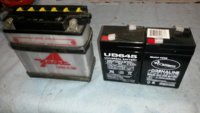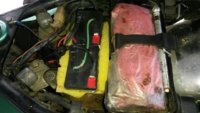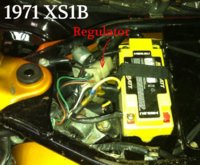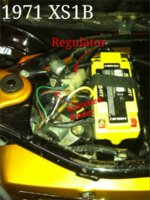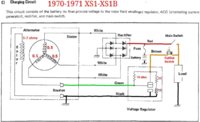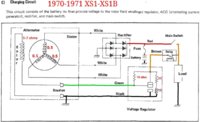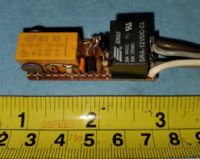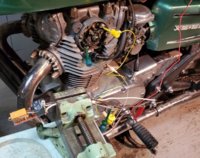One of the things I've never liked about the XS is the fact that the alternator is energized as soon as you turn the key on. Another dislike of mine is the way the headlight is turned on. Here's whats happening.....
The ignition switch (hereafter just called the iggy sw.) supplies power to the fuse box. The fuse box in turn sends 12v to the regulator. The engine's not running yet, so the alternator isn't producing any power.... 0 volts. The regulator... bless it's heart, is just a dumb box. All it see's is a low voltage condition. Wanting to balance the equation, it sends all the power it can to the rotor to increase it's field strength, trying to get the alternator to put out about 14v...... which it can't do because.... well, the engines not running yet.
That current draw from the regulator and rotor comes out to about 2.5 to 3 amps. Don't sound like much, but lets face it.... the XS starter ain't exactly a world class powerhouse. Add to that a marginal or weak battery.... and the ol' 'lectric leg has to work hard to get it's job done. that 2.5-3 amps could be better spent helping the starter instead of fighting it.
And fight it... it most certainly does. That lost power is used to energize the rotors magnetic field, which now has to spin inside the stator. It ain't much, but that's extra horsepower the starter has to supply to overcome the magnetic field and spin the engine.
I ain't an engineer, so I honestly can't tell you how much power that field robs from the starter... but ANY power loss seems counter-intuitive in my mind. Why make the starter work harder when we don't have to? We don't need the alternator yet, so why in hell are we turning it on? Makes no sense.
Another problem is the way the lights are turned on. The alternator output is also sent to the safety relay on the single yellow wire. As soon as the safety relay sees an output from the alternator, it latches and turns the lights on. And we've all had this happen.... we hit the start button, the engine spins over, fires once or twice and then dies. The alternator generates just enough power to latch the safety relay and now the lights are on. We are now robbing even more power from the battery just when we need it for the starter. Why?
So, here's the solution.... we interrupt power to the regulator during start with a normally closed (NC) relay.
Like this....

The 12v from the fuse box normally goes straight to the reg./rec. powering the alternator. Instead, we route that power to the "Alt Disable Relay".... (ADR). Power goes through the contacts to the reg. when the bike is running. During start, the 12v from the starter solenoid is (also) sent to the ADR coil which opens the contacts and shuts off the regulator.... which in turn, shuts off the alternator. Now there is no power being lost and no additional load (from the magnetic field) on the starter.
As soon as the engines starts, we release the starter button, the relay closes, the alternator comes to life and the lights come on. It's such a simple mod I can't understand why Yamaha didn't just include the relay when they built the bike.
My original plan was to incorporate this mod into the SG and then put up some quantifiable results. Right now I'm laid up and unable to work on the bike.... and bored to friggin tears. Writing this gives me something to do and an idea for you guys to chew over. If anyone's interested in trying this I'll add the part no. of the relay I'm using and my thoughts on where to tie into the existing wiring.
Cheers.
*** The brown wire from the ADR runs just to the regulator on 70-79 bikes. It splits and runs to the Reg/rec and the rotor (brush) on 80 and up bikes.
The ignition switch (hereafter just called the iggy sw.) supplies power to the fuse box. The fuse box in turn sends 12v to the regulator. The engine's not running yet, so the alternator isn't producing any power.... 0 volts. The regulator... bless it's heart, is just a dumb box. All it see's is a low voltage condition. Wanting to balance the equation, it sends all the power it can to the rotor to increase it's field strength, trying to get the alternator to put out about 14v...... which it can't do because.... well, the engines not running yet.
That current draw from the regulator and rotor comes out to about 2.5 to 3 amps. Don't sound like much, but lets face it.... the XS starter ain't exactly a world class powerhouse. Add to that a marginal or weak battery.... and the ol' 'lectric leg has to work hard to get it's job done. that 2.5-3 amps could be better spent helping the starter instead of fighting it.
And fight it... it most certainly does. That lost power is used to energize the rotors magnetic field, which now has to spin inside the stator. It ain't much, but that's extra horsepower the starter has to supply to overcome the magnetic field and spin the engine.
I ain't an engineer, so I honestly can't tell you how much power that field robs from the starter... but ANY power loss seems counter-intuitive in my mind. Why make the starter work harder when we don't have to? We don't need the alternator yet, so why in hell are we turning it on? Makes no sense.
Another problem is the way the lights are turned on. The alternator output is also sent to the safety relay on the single yellow wire. As soon as the safety relay sees an output from the alternator, it latches and turns the lights on. And we've all had this happen.... we hit the start button, the engine spins over, fires once or twice and then dies. The alternator generates just enough power to latch the safety relay and now the lights are on. We are now robbing even more power from the battery just when we need it for the starter. Why?
So, here's the solution.... we interrupt power to the regulator during start with a normally closed (NC) relay.
Like this....
The 12v from the fuse box normally goes straight to the reg./rec. powering the alternator. Instead, we route that power to the "Alt Disable Relay".... (ADR). Power goes through the contacts to the reg. when the bike is running. During start, the 12v from the starter solenoid is (also) sent to the ADR coil which opens the contacts and shuts off the regulator.... which in turn, shuts off the alternator. Now there is no power being lost and no additional load (from the magnetic field) on the starter.
As soon as the engines starts, we release the starter button, the relay closes, the alternator comes to life and the lights come on. It's such a simple mod I can't understand why Yamaha didn't just include the relay when they built the bike.
My original plan was to incorporate this mod into the SG and then put up some quantifiable results. Right now I'm laid up and unable to work on the bike.... and bored to friggin tears. Writing this gives me something to do and an idea for you guys to chew over. If anyone's interested in trying this I'll add the part no. of the relay I'm using and my thoughts on where to tie into the existing wiring.
Cheers.
*** The brown wire from the ADR runs just to the regulator on 70-79 bikes. It splits and runs to the Reg/rec and the rotor (brush) on 80 and up bikes.
Last edited:


